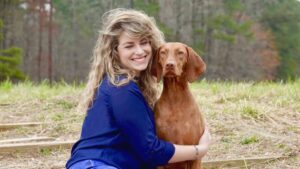
Michelle Porfido-DeLucia | Rhapsody Vizslas
Michelle Porfido DeLucia is the breeder behind Rhapsody Vizslas. Read about the kennel’s beginnings, puppies, and much more!

Home » Dog Breeds » Vizsla Dog Breed
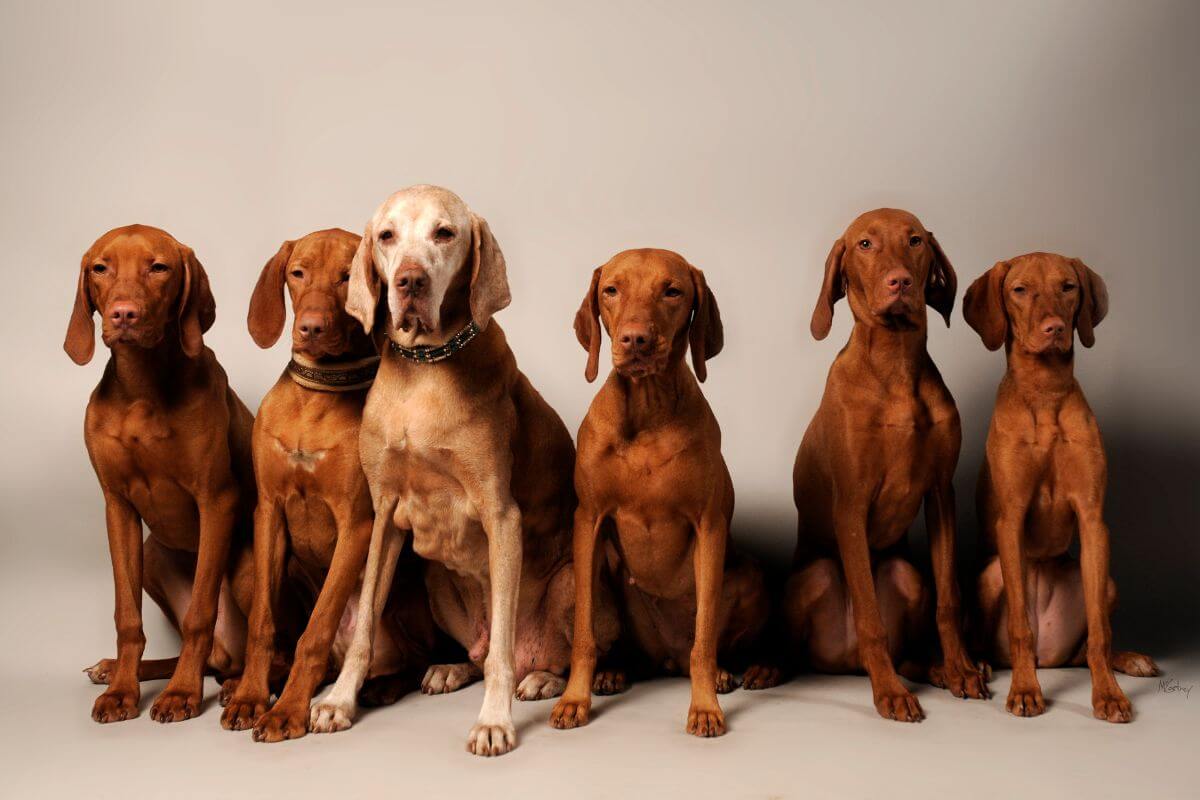


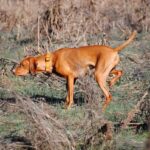

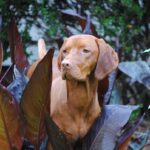
The Vizsla, or the “Hungarian Pointer,” is a breed of dog renowned for its elegant bearing and distinguished golden-rust-colored coat. Originally bred by the Magyars, the ancestors of the modern-day breed were highly valued for their speed and strength. Their descendants today are admired for these qualities as well as for their versatile hunting skills and affectionate nature. The breed is known for the close bond it shares with its human companions, displaying a level of loyalty and responsiveness that makes it an outstanding family pet and an excellent field dog. A gentle demeanor, combined with an enthusiastic attitude, makes this breed a popular choice for those who enjoy spending time outdoors.
Sporting
21 – 24 Inches
44 – 60 Pounds
12 – 14 Years
| Country of Origin | Hungary |
|---|---|
| Bred For | Pointing, Retrieving |
| Known For | Attractive Color, Sleek Coat, Trainability |
| Popularity | High |
| Temperament | Affectionate, Energetic, Lively |
| Activities | Bird Dog, Running, Swimming, Conformation Shows, Dog Sports |
The Vizsla, a breed with a rich and expansive history, is one of the oldest known hunting dogs. Its origins trace back over a thousand years to the early Magyar tribes who migrated to what is now Hungary. The early Vizslas were valued companions of the Magyar hunters and warriors, revered for their exceptional hunting skills and loyal nature.
The breed’s development was influenced by the varied geography and game found in Hungary. The Vizslas were bred to be versatile and resilient, capable of pointing and retrieving in the dense forests and on the open plains alike. Their keen sense of smell, agility, and endurance made them ideal for hunting fowl and game.
Over the centuries, the role of Vizslas expanded beyond hunting. They became symbols of nobility and status among the Hungarian aristocracy. The breed’s purity was fiercely protected, and its breeding was often restricted to the nobility that owned much of the land.
The turmoil of wars and political changes in Europe posed significant threats to the breed’s existence. The Vizsla suffered during the World Wars, with its numbers dwindling to dangerously low levels. However, dedicated breeders in Hungary, and later, in other parts of the world, worked tirelessly to preserve and revive the breed.
The Vizsla was officially recognized by the American Kennel Club (AKC) in 1960. This recognition marked a turning point for the breed, leading to increased interest and popularity in the United States. Similarly, The Royal Kennel Club (UK) and the Fédération Cynologique Internationale (FCI) have recognized the breed, further securing its status in the canine world.
The modern Vizsla has retained much of its ancestral traits. The breed is still prized for its hunting abilities, but it has also gained recognition as versatile competitors in dog sports and dog shows, and as a beloved family companion. The affectionate nature of this loving and loyal breed, combined with its athletic build and great intelligence, makes it well-suited for a variety of roles and home settings.
An adult male Vizsla typically stands between 22 and 24 inches tall at the shoulder, while a mature female is slightly shorter, ranging from 21 to 23 inches tall.
In terms of weight, a male usually weighs around 55 to 60 pounds, with a female generally falling within the range of 44 to 55 pounds.
The Vizsla exhibits a well-proportioned body that speaks to its agility and endurance. The body is slightly longer than it is tall, measured from the point of the breastbone to the point of the buttocks and from the highest point of the shoulder blades to the ground. This contributes to the breed’s streamlined, athletic appearance and its usefulness as a pointer and retriever. The body is solid but not bulky, with a rather light build and just enough muscle mass to support vigorous activity without impeding swiftness. The breed’s overall impression is one of balance and strength, a perfect embodiment of power, drive, and endurance.
Texture: The Vizsla has a short, smooth, and dense coat, offering protection in all types of weather and various terrain. The close-lying nature of the coat accentuates the dog’s streamlined, athletic body, allowing for unhindered movement in dense brush and thick brambles. This type of coat is relatively easy to keep, requiring minimal grooming to maintain its sleek appearance.
| Standard Color | |
|---|---|
| Golden Rust | ee |
| Golden | ee |
| Red | ee |
| Red Golden | ee |
| Rust | ee |
| Rust Golden | ee |
| Sandy Yellow | ee |
Markings: White Markings
A Note About Color: The Vizsla is a self-colored dog, with the eyes, eye rims, nose, lips, toenails, and pads of the feet blending with the coat. Always a golden rust color of varying shades, the breed displays lighter shadings over the sides of the neck and shoulders. This “saddle” is acceptable; however, pale yellow and solid dark mahogany colors are not. White markings on the toes and/or a small spot on the forechest may appear, but any other areas of white are unacceptable in the breed.
The Vizsla’s tail is strong and of medium length, set just below the level of the croup. This positioning allows for a smooth, flowing line from the top of the shoulders to the tip of the tail. This is a hallmark of the breed. The tail is carried horizontally or slightly elevated when the dog is in motion, displaying the breed’s energetic and alert nature.
Traditionally, Vizslas have had their tails docked, although this practice varies today based on regional norms and regulations. In countries where docking is permitted, the tail is typically docked to two-thirds its original length. This is done to protect the tail from injury in rough cover. However, on dogs with full-length sterns, the tail is straight or slightly curved, but it is never sickle-shaped.
Owning a Vizsla, a breed well-known for its affectionate nature and dynamic energy, is a rewarding experience for many. These dogs are not just pets but become an integral part of the family, offering reliable companionship and endless joy. However, prospective Vizsla owners should consider the breed’s specific needs and characteristics to ensure they can provide a suitable environment and appropriate care.
Generally, the Vizsla is a robust and healthy dog, possessing a strong and athletic build. It is known for its longevity and vitality, often leading an active lifestyle well into its senior years. Prospective owners should be aware of the breed’s health profile and make sure they have access to quality veterinary care that will help with maintaining the dog’s overall health.
Lifespan: The average lifespan of a Vizsla is typically between 12 and 14 years. With attentive care, a balanced diet, and regular exercise, many Vizslas live long and fulfilling lives, bringing happiness and companionship to their families for many years.
Despite the breed’s overall robust health, Vizslas can be predisposed to certain health conditions that prospective owners should become aware:
It is crucial for Vizsla owners to have a relationship with their dog’s breeder and to provide regular veterinary check-ups, including specific screenings for common breed-related health issues. With proactive and preventive healthcare, the Vizsla can enjoy a high quality of life and remain active and healthy companions for many years.
The Vizsla is known for its affectionate, gentle, and intelligent personality, making it an excellent companion in family settings and as a working gundog. Vizslas thrive on human companionship, often forming strong, loyal bonds with their caretakers. The breed is often a good fit for novice owners due to its eagerness to please and its trainability. The sensitivity level of most Vizslas is high, making them responsive to their owner’s emotions and moods.
Being alone for extended periods can be challenging for a Vizsla, as the breed can be prone to separation anxiety due to its deep need for attachment to people. It is important for owners to provide these dogs with enough attention and to not leave them isolated for long durations. Thankfully, they are generally good with other dogs and enjoy their company, often displaying a playful and sociable demeanor. However, early socialization is key to make sure they are well-adjusted and confident meeting new canine companions.
Vizslas are also known to be good with young children, showing patience and gentleness. Their friendly disposition extends to strangers as well, although they can be cautious in new encounters. Proper socialization from a young age helps in developing their confidence and making sure they are well-behaved around new people and new environments.
Overall, the Vizsla’s personality is one of warmth and intelligence, and an eagerness to be part of family activities. These dogs are adaptable, loyal, and affectionate, making them cherished companions. However, their high energy levels and need for interaction mean they are best-suited to an active lifestyle and an environment where they can be closely involved with their human family members.
Feeding a Vizsla properly is crucial for maintaining its health, energy, and overall well-being. This breed, known for its active lifestyle, requires a balanced diet rich in nutrients to sustain its energy levels. When feeding a Vizsla puppy, it’s important to provide a diet formulated for high-energy breeds, which supports their rapid growth and development. Puppy-specific food should be given until they reach about 80% of their expected adult size.
For adult Vizslas, the diet should transition to a formula appropriate for active, medium-sized breeds. The amount of food a Vizsla requires varies depending on its age, size, metabolism, and activity level, but generally, an adult Vizsla might consume between 2 to 3 cups of dry dog food per day, divided into two meals. It’s essential to monitor their weight and adjust portions accordingly to avoid overfeeding, as obesity can lead to health problems.
Vizslas are often enthusiastic eaters and may eat quickly. Using a slow-feeder bowl can help prevent digestive issues like bloat, especially since they are a breed that can be prone to this condition. Always make sure that fresh water is available, especially considering their high activity levels.
Remember, each dog is unique, and dietary needs can vary. Regular check-ups with a veterinarian can help determine the most appropriate diet for an individual dog’s specific health and lifestyle needs.
Training a Vizsla can be a rewarding experience due to their intelligent and eager-to-please nature. This breed is generally easy to train, responding well to positive reinforcement techniques such as praise, play, and food rewards. Vizslas are known for their high intelligence, making them quick learners who are receptive to commands and eager to impress their human companions.
Despite their intelligence, Vizslas can sometimes be distracted by their surroundings, especially if they pick up interesting scents, given their hunting background. Therefore, consistent and patient training sessions are important. Early socialization and puppy training classes are highly recommended to help them develop into well-adjusted adults.
As for their tendency to bark, Vizslas are not typically excessive barkers. However, like any dog, they may bark to alert their owners to something unusual or when they feel anxious. Training and socialization can help manage any unwanted barking behavior.
Their potential for wanderlust or predation can be managed with proper training and secure fencing. Due to their hunting instincts, it’s important to keep a Vizsla on a leash or in a secured area, as they might chase after small animals or follow an interesting scent.
The exercise needs of a Vizsla are significant, reflecting their energetic and athletic nature. This breed thrives on physical activity and requires regular exercise to maintain their health and happiness. Vizlas typically have a high energy level, making them well-suited for active families or individuals who enjoy an outdoor lifestyle.
| Energy Level | High |
|---|---|
| Exercise Requirements | 2 Hours/Day (Minimum), Daily Walks, Vigorous Running, Regular Exercise, Occasional Swimming, Playing with Another Dog, Mental Stimulation |
Regular, vigorous exercise is essential for a Vizsla. Activities like long walks, runs, hikes, or play sessions in a securely fenced area are ideal for keeping them physically fit and mentally stimulated. The intensity of the exercise should match the dog’s age, health, and fitness level. Puppies and young dogs may have bursts of high energy, while older dogs might prefer more moderate activities.
Playfulness is a key trait of the Vizsla, and they often enjoy interactive games such as fetch, frisbee, or tug-of-war. These activities not only provide physical exercise but also strengthen the bond between the dog and its owner.
It’s important to note that Vizslas require more than just physical exercise; they also need mental stimulation. Activities that challenge their minds, like obedience training, agility courses, or scent work, can be very beneficial. These not only tire them out physically but also keep their minds engaged, preventing boredom and destructive behaviors.
Grooming a Vizsla is relatively straightforward due to their short, smooth coat, making them an ideal choice for individuals who prefer a low-maintenance dog. The coat of a Vizsla does not require extensive grooming but should be brushed regularly to remove loose hair and maintain its healthy shine. This breed is known for shedding, albeit moderately, so regular brushing will help manage loose hair and keep it off furniture and clothing.
| Coat Type | Single, Short, Smooth, Dense, Close-Lying |
|---|---|
| Grooming Requirements | Weekly Brushing, Occasional Bathing, Routine Ear Cleaning, Periodic Nail Trimming, Regular Tooth Brushing |
Bathing a Vizsla should be done as needed, depending on their activity level and lifestyle. Since they have a short coat, they are prone to getting cold, so it’s important to dry them thoroughly after bathing, especially in cooler weather. Using a mild dog shampoo will help preserve the natural oils in their skin and coat.
Other aspects of grooming include regular nail trimming to prevent overgrowth and splitting, which can be painful and lead to problems walking. Ear care is also essential, as their floppy ears can be prone to infection. Regular checks and gentle cleaning can prevent issues.
Dental hygiene is another important aspect of grooming. Regular brushing of the teeth or use of dental chews can help prevent tartar build-up and gum disease.
Adapting to life with a Vizsla involves understanding and catering to their unique needs in terms of environment and climate. Although energetic and active by nature, Vizslas are quite adaptable and can comfortably reside in apartments, provided they receive ample daily exercise. It’s essential for them to engage in activities like long walks or runs, as well as interactive play sessions, to keep them physically fit and mentally sharp. Their need for human interaction is high, making them less suitable for environments where they would be left alone for extended periods.
When it comes to weather, Vizslas have certain sensitivities due to their short coats. They are not well-equipped for cold climates, lacking an undercoat to provide insulation. In colder regions, owners should take extra care to keep their Vizsla warm during outdoor activities, using dog sweaters or coats, and prioritizing indoor living to maintain their comfort.
Conversely, Vizslas fare better in warmer climates, thanks to their short, sleek fur. However, during particularly hot days, it’s crucial to make sure that they have access to cool, shaded areas and plenty of water. Exercise routines should be adjusted to avoid the peak heat of the day, thereby preventing any risk of overheating or heat-related stress.
The key to a harmonious life with a Vizsla lies in integrating them into the family’s daily life. They are affectionate and thrive on involvement in family activities. Providing a balanced environment where they have enough space to play, opportunities for regular exercise, and abundant time with their human family is essential for their well-being.
The arrival of a litter of Vizsla puppies is an exciting and rewarding experience. These pups are known for their boundless energy, curiosity, and affection. From the moment they enter the world, Vizsla puppies demand attention, training, and a lot of love. They grow rapidly, both physically and mentally, and require consistent guidance to develop into well-behaved adult dogs. It is essential for prospective owners to understand the commitment involved in raising a Vizsla pup, as the formative first few months are crucial for setting the foundation for future behavior and health.
Caring for a Vizsla puppy involves several key aspects to help it grow into a healthy and happy adult. One of the first priorities is establishing a regular feeding routine with a high-quality puppy diet that is formulated for medium-sized breeds. This diet should support the pup’s rapid growth and high energy levels. Frequent, smaller meals are recommended to aid in digestion and maintain steady energy levels throughout the day.
Early socialization is also critical for the Vizsla puppy. Exposure to various people, pets, and environments helps it become a more well-rounded and confident dog. Positive experiences during this stage can positively shape both temperament and behavior.
Training should begin as soon as a Vizsla puppy arrives at its new home. The little one is already intelligent and eager to learn, making it responsive to early training. Basic commands, housetraining, and crate training are essential components of its early education. Positive reinforcement methods work best, as Vizslas are sensitive and respond well to praise and rewards.
Regular veterinary check-ups are crucial to monitor the pup’s growth and health. This includes vaccinations, deworming, and any other preventive care recommended by the vet. Attention should also be given to its dental health, with regular teeth brushing or dental treats given that promote good oral hygiene.
Physical exercise should be appropriate for the age and development stage of the Vizsla. Puppies have a lot of energy, but its bones and joints are still developing, so care should be taken to avoid overly strenuous activities.
Vizslas are versatile and athletic dogs, excelling in a variety of doggy activities. Participation in Companion and Performance events not only provides physical and mental stimulation for the dog, it also strengthens the bond between the dog and its handler. Here are some dog sports for which the typical Vizsla is well-equipped:
Participation in these dog sports can be incredibly fulfilling for the Vizsla, as the breed loves to work in partnership with its handler and enjoys being mentally and physically engaged. For Vizsla owners, these activities offer a unique way to interact with their dogs, building a deeper understanding and a stronger relationship.
The Vizsla is recognized by the world’s leading registries and kennel organizations, which categorize the breed into a specific Group based on its unique characteristics. This breed is recognized worldwide under the following Group designations:
| Organization | Group Designation |
|---|---|
| AKC (American Kennel Club) | Sporting |
| UKC (United Kennel Club) | Gun Dog |
| CKC (Canadian Kennel Club) | Sporting Dogs |
| ANKC (Australian National Kennel Council) | Gundogs |
| RKC (The Royal Kennel Club) | Gundog |
| FCI (Fédération Cynologique Internationale) | Group 7: Pointing Dogs Section 1: Continental Pointing Dogs |
The ideal Vizsla is described by a Breed Standard that is approved by each of the world’s leading registries and kennel organizations. The Breed Standards for this breed may be found in the following links:
| Organization | Breed Standard |
|---|---|
| American Kennel Club | AKC Vizsla Breed Standard |
| United Kennel Club | UKC Vizsla Breed Standard |
| Canadian Kennel Club | CKC Vizsla Breed Standard |
| Australian National Kennel Council | ANKC Vizsla Breed Standard |
| The Royal Kennel Club | RKC Vizsla Breed Standard |
| Fédération Cynologique Internationale | FCI Vizsla Breed Standard |
Dog clubs play an important role in the preservation, promotion, and education of the Vizsla. These organizations not only provide a meeting space for breed enthusiasts to share passion, they also serve as valuable resources for current and prospective breeders of this exceptional companion.
In the United States, the Vizsla Club of America (VCA) is the primary organization dedicated to the breed. The VCA focuses on various aspects of breed ownership, including education, health and genetics, rescue efforts, and organizing events such as Conformation dog shows and Field Trials. It also provides a platform for networking and sharing information among Vizsla owners across the country.
Canada is home to Vizsla Canada, a national club that represents Vizsla interests across the country. This organization is involved in promoting the breed’s health and welfare, organizing social and competitive events, and offering guidance and information to both Vizsla owners and the dog-loving public.
In the United Kingdom, The Hungarian Vizsla Club and The Hungarian Vizsla Society are the key organizations. Both clubs are dedicated to the protection and promotion of the breed. They organize events, promote the Breed Standard, and offer guidance on Vizsla care and training. Their members also play a significant role in welfare and rescue operations for Vizslas in need.
These clubs, along with regional and local clubs, are vital in providing support for Vizsla owners and breeders. Their members offer educational resources, organize events that showcase the breed, and provide forums for discussions on breed-specific topics. Additionally, they play a significant role in rescue and rehoming efforts, ensuring the welfare of Vizslas that are in need of assistance.
Breed rescue groups play an indispensable role in ensuring the welfare of any Vizsla in need. Their volunteers are dedicated to rescuing, rehabilitating, and rehoming dogs that have been abandoned, lost, or surrendered, offering them a chance for a better life.
In the United States, there are several Vizsla-specific rescue organizations:
Rescue Me! This group provides a platform for shelters and individuals to post Vizslas looking for a new home.
Midwest Vizsla Rescue, a non-profit organization, intervenes on behalf of homeless Vizslas, receiving dogs from shelters or through owner surrenders.
New Hope Vizsla Rescue, based in Pennsylvania, focuses on helping Vizslas in the PA, NJ, DE, and MD but collaborates with other groups as needed.
Buckeye Vizsla Rescue, Inc., formed in 2014, is dedicated to rescuing purebred Vizslas from various sources.
Southern California Vizsla Rescue places Vizslas in need, focusing on those that can adapt well to homes with other dogs, children, and working family members.
In Canada, the Vizsla Society of Ontario is a well-known entity in the rescue and rehoming of Vizslas. They provide resources and support for individuals looking to rehome a Vizsla.
The United Kingdom is home to organizations with a focus on Vizsla welfare. The Vizsla Welfare Charity, the first independent UK charity dedicated to the Hungarian Vizsla, focuses on rehoming, health and wellness, and breed welfare. The Hungarian Vizsla Society’s Vizsla Rescue also offers support and rehoming services for Vizslas across the UK.
Besides these breed-specific rescue groups, local animal shelters may occasionally have a Vizsla or Vizsla-mix available for adoption. These facilities can be crucial for offering assistance to adopters and connecting them with members of a local or national breed club.
Vizslas do shed, although typically less than many other breeds due to their short, smooth coat. Their shedding is moderate, however, and can be managed with regular brushing, which helps to remove loose hair and maintain the coat’s overall health. Owners may notice an increase in shedding during seasonal changes, but overall, Vizslas are not considered heavy shedders.
Vizslas generally have a lifespan of around 12 to 14 years. Their longevity can be attributed to their overall robust health and active lifestyle. However, like all breeds, their lifespan can be influenced by factors such as genetics, diet, exercise, and the quality of veterinary care they receive throughout their life.
Vizslas are not considered hypoallergenic. While they have a short coat and shed less than many breeds, they still produce dander and saliva, which are common allergens for many people. For individuals with dog allergies, spending time with a Vizsla before making a commitment is advisable to ensure compatibility.
Vizslas are excellent family dogs, widely known for their affectionate and gentle nature. They thrive in a family environment and form strong bonds with all family members, including children. Their playful and loving demeanor makes them a wonderful addition to a family, provided they receive adequate exercise and attention.
The correct pronunciation of ‘Vizsla’ is “VEEZ-shlah.” The emphasis is on the first syllable, with a”‘v” sound as in the word “very,” and the “s” is pronounced as “sh.” The name comes from the Hungarian language, reflecting the breed’s country of origin.
Vizslas are medium-sized dogs. Adult male Vizslas typically stand between 22 and 24 inches tall at the shoulder, with females slightly smaller, ranging from 21 to 23 inches tall. In terms of weight, males usually weigh around 55 to 60 pounds, while females are generally in the range of 44 to 55 pounds.
Vizslas are highly intelligent dogs, known for their quick learning ability and problem-solving skills. Their intelligence, coupled with their eagerness to please, makes them highly trainable. This intelligence requires regular mental stimulation to prevent boredom and to promote a well-behaved demeanor.
Vizslas generally enjoy swimming and are natural swimmers. Their lean, athletic build makes them well-suited for water-based activities. Swimming is a great way for Vizslas to exercise, especially during warmer months, as it provides a fun and effective way to burn energy.
Vizslas are known for their speed and agility. They can reach speeds of up to 40 miles per hour, making them one of the faster dog breeds. This speed, combined with the breed’s notable endurance, makes these dogs excellent running companions and highly skilled competitors in various dog sports.
Vizslas typically stop growing by the age of 18 to 24 months. However, they may continue to fill out and gain muscle until they are about 2 to 3 years old. It is important for their growth to be supported with appropriate nutrition and exercise during their developmental stages.
Vizslas can be good with cats, especially if they are raised with them from a young age. Their hunting heritage means they can have a high prey drive, so early socialization and training are important. Each dog has a unique temperament, of course, so careful introduction and supervision are key when introducing them to cats.
Vizslas are not typically aggressive. TInstead, they are well-known for their gentle and affectionate nature. However, like any dog, their behavior can be influenced by genetics, upbringing, training, and socialization. Proper training and early socialization are crucial in preventing any aggressive tendencies.
Vizslas are not known for excessive barking. They may bark to alert their owners to something unusual, but they are generally not nuisance barkers. Proper training, and making sure they have enough mental and physical stimulation, can help to manage any excessive barking tendencies.
Vizslas are often referred to as “Velcro dogs” due to their affectionate nature and love for cuddling. They enjoy being close to their human family members and often seek physical closeness. Their desire to cuddle and be near their owners is a noteworthy characteristic of the breed.

Michelle Porfido DeLucia is the breeder behind Rhapsody Vizslas. Read about the kennel’s beginnings, puppies, and much more!

Susan Nakamura is the breeder behind Suzu Vizslas . Read about the kennel’s beginnings, Suzu Vizslas puppies, and much more!
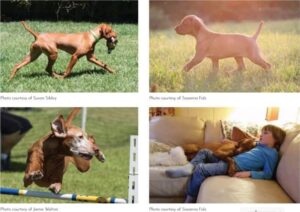
This article focuses on the medium-sized Vizsla but delves into the confusing use of “medium” in the Sporting Group. Read more.
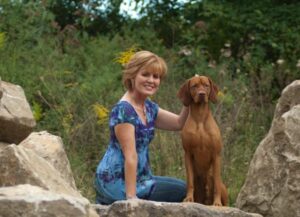
Corrinne Miklos is the breeder behind Grouse Point Vizslas. Read about the kennel’s beginnings, the sires, the dams, the puppies, and more!
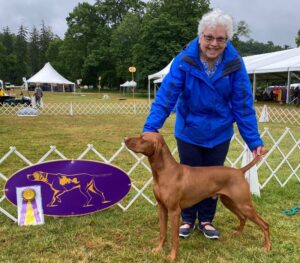
Gail Fleming is the breeder behind Pursuit Vizslas. Read about the kennel’s beginnings, the sires, the dams, the puppies, and more!

Any good dog parent knows that ALL dogs have the potential to help us stay active. That being said, check out this list of energetic dogs.
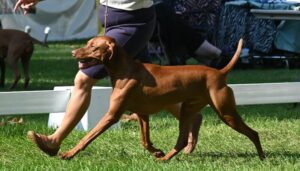
Ringside photos from the Vizsla Club of America Specialty which was held on Sep 29 – Oct 02, 2022, in Kennewick, WA.

Walter & Carol Sommerfelt: Where do we live? How many years in dogs? How many years as a breeder? We live in Lenoir City, Tennessee, just
The best way to ensure a long and happy relationship with a purebred dog is to purchase one from a responsible breeder. Not sure where to begin?
Contact the National Parent Club’s Breeder Referral Program, which is listed on the AKC Breeder Referral Contacts page.
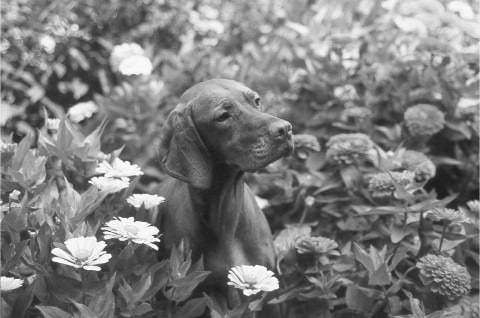

"*" indicates required fields
Showsight Magazine–the world’s most influential purebred dog publication since 1992. Each issue reaches a global audience dedicated to preserving the history and health of purpose bred dogs. Filled with award-winning editorial focused on news and insights from the dog show community, top breeders, handlers, AKC Judges, and more!